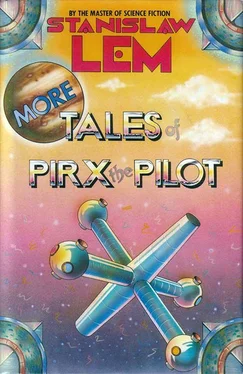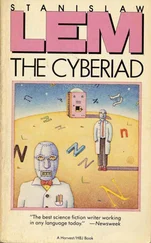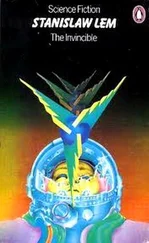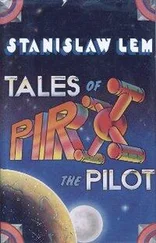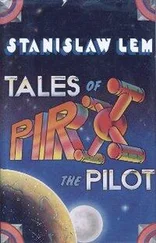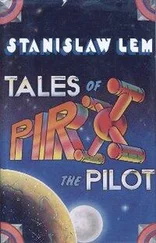The night crew went off at 0700, and visitors were allowed into the control tower between shifts. He packed away his few toilet articles and, thinking he’d better make sure the unloading of the Cuivier was going according to schedule, went out. All his package cargo had to be off by 1200 hours, and there were still a few things worth testing—such as the servo-reactor’s cooling system—all the more so since he was going back a man short (getting a substitute for Terman was wishful thinking). He mounted a spiral, polyfoam-padded staircase, his hand on the astonishingly warm (heated?) banister, and when he reached the upper level and opened the swinging glass door with frosted panes, he entered a world so different that he felt like someone else.
It could have been the interior of a giant head, with six enormous, bulging glass eyes fixed in three directions at once. The fourth wall was mounted with antennas, and the whole room rotated on its axis like a revolving stage. In a sense, it was a stage, where the same performance, that of lift-off and landing, clearly visible a kilometer away from behind the rounded control consoles that blended perfectly with the silver-gray walls, was played and replayed. The atmosphere was reminiscent both of an airport control tower and an operating room.
Along the wall of antennas, under a sloping hood, reigned the main space-traffic computer, always in direct contact, always blinking and ticking, continually carrying out its mute monologues and spewing reams of perforated tape. Near it were stationed three back-up terminals, with mikes, spotlights, swivel chairs, and the controllers’ hydrant-shaped hand calculators; and finally, a cute, contoured little bar with a softly humming espresso machine. So here was the coffee trough.
Pirx couldn’t see the Cuivier from the tower; he had parked it, in compliance with the controller’s instructions, five kilometers away, beyond all the clutter, to make way for the project’s first supership landing—as if it wasn’t equipped with the latest space- and astrolocational computers which, according to the bragging of the shipyard builders (nearly all personal acquaintances of Pirx), could plant that Goliath of a quarter-miler, that iron mountain, on a site no bigger than a kitchen garden. All three shifts were mustered for the occasion, which, for all its festivity, was not an official celebration: the Ariel, like every other prototype, had posted dozens of experimental flights and lunar landings, though, to be sure, never with a full cargo.
With a half hour to go before touchdown, Pirx greeted those who were off duty and shook hands with Seyn. The monitors were already activated, blurry smudges ran from top to bottom on the cathode-ray tubes, but the lights on the landing terminal were uniformly green, meaning they still had time to kill. Romani, the Base coordinator, offered him a glass of brandy with his coffee. Pirx hesitated—he wasn’t used to tippling at such an early hour—but, then, he was there as a private guest and was sensitive enough to see they were only trying to lend the event a touch of class. They’d waited months for the superfreighters, whose arrival was calculated to save Port Control untold headaches, since until now it had been a perpetual contest between the voracious appetite of the construction site, never satisfied by the project’s cargo fleet, and the efforts of transport pilots like Pirx to ply the Mars-Earth run as quickly and efficiently as possible. With the conjunction now over, both planets were beginning to move farther apart, the distances between them to increase yearly until reaching an alarming maximum of hundreds of millions of kilometers. It was in this, the project’s hour of greatest travail, that relief was at hand.
The talking was subdued, and when the green lights faded and the buzzers sounded, there was dead silence. A typical Martian day was breaking: not cloudy, not clear, no distinguishable horizon, no well-defined sky, as if devoid of any definable, measurable time. Despite the daylight, the perimeters of the concrete squares hugging the Agathodaemon floor were fringed with glowing lines—automatic laser markings—and the rim of the concrete circular shield, almost black, was edged with sparkling, starlike beads. The controllers, idled, made themselves comfortable in their armchairs, while the central computer flashed its diodes, as if to proclaim its indispensability, and the transmitters had begun to drone ever so softly when a clear bass came over the loudspeaker:
“Hello, Agathodaemon, this is Ariel, Klyne speaking; we’re on video, altitude six hundred, switching to automatic landing in twenty secs; over.”
“Agathodaemon to Ariel,” Seyn, having just put out his cigarette, replied eagerly, his beaklike profile up close to the mesh of the microphone. “We have you on all screens; lie down and let her roost; over.”
They’re goofing around, thought Pirx, who, superstitious as he was, didn’t like it, though they obviously had the landing procedure down pat.
“Ariel to Agathodaemon: we have three hundred, switching to automatic, descending with no lateral drift, zero on zero, what’s the wind force? Over.”
“Agathodaemon to Ariel: wind at a hundred eighty per hour, north-northwest, won’t bother you; over.”
“Ariel to everybody: descending in the axis, stern first, on automatic; over and out.”
Silence fell; only the transmitters were mincing away as a flaming white speck, swelling as fast as a bubble being blown out of fiery glass, appeared on the screens. It was the ship’s gaping tail section, descending as if on an invisible plumb line, without the slightest jerking or tilting or gyrating. Pirx thrilled to see it. Altitude at about a hundred kilometers, he guessed; no sense watching until it was down around fifty; besides, the observation windows were too crowded with craning heads as it was.
Ground control was in constant radio contact with the ship, but there was nothing to radio, leaving the crew to sit back in their antigravitational chairs and trust to the computers commanded by the ship’s primary computer, which had just ordered a shift from atomic to boron drive at an altitude of sixty kilometers, or at the point of atmospheric entry. Pirx now walked up to the middle window, the largest, and immediately sighted through the sky’s pale blur a bright green sparkle, microscopic but vibrating with uncommon radiance—as if the Martian horizon were being drilled from above with a burning emerald. From this incandescent speck, pale filaments fanned in all directions—cloud wisps, or, rather, those aborted clouds-to-be which in the local atmosphere served as surrogates for the real thing. Sucked up into the orbit of the ship’s rocket flare, they ignited and exploded like fireworks. The ship’s circular flange swelled. The air was visibly palpitating from the exhaust, which a novice might have mistaken for a slight vacillation, but Pirx was too experienced to be fooled. Things were going so smoothly, so routinely, that he was reminded of the ease with which the first human step on the Moon had been taken. By now the fuselage was a burning green disk ringed with a scintillating halo. He glanced at the main altimeter above the control terminals—the altitude of such a supership was easy to misjudge; eleven, no, twelve kilometers separated the Ariel , decelerating in response to the reverse thrust, from Mars.
Then several things happened at once.
The Ariel’s stern nozzles, in a nimbus crowned with green rays, began to vibrate in a different way. Over the loudspeaker came a tumult, a muffled cry, something like “Manual!” or maybe “Many!”—one inscrutable word shouted by a human voice, too altered to have been Klyne’s. A second later, the green blaze spewing from the Ariel’s stem paled, then ballooned into an awesome blue-white incandescence—and Pirx understood at once, in a shudder of dread that shook him from head to toe, so that the hollow voice booming from the loudspeaker surprised him not at all.
Читать дальше
